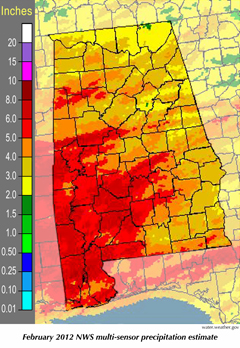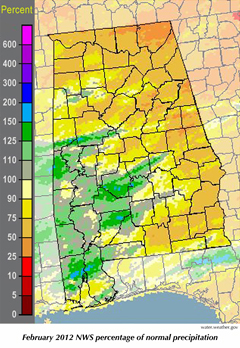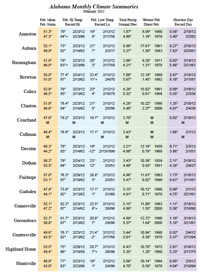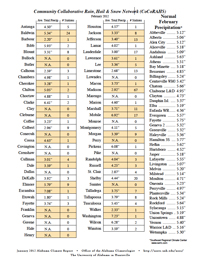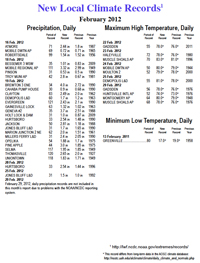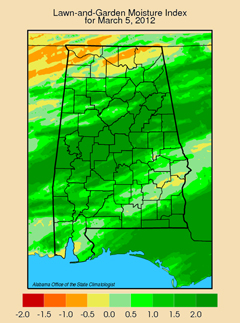 |
|||||||||||||||||||||||||||||||||||||||||||||||||||||||||||||||||||||||||||||||||||
Volume 3, Number 5, February, 2012 |
|||||||||||||||||||||||||||||||||||||||||||||||||||||||||||||||||||||||||||||||||||
|
If you were living in Alabama in March 1993, what you remember about the great blizzard of that month probably depends greatly on two things: One, being old enough to remember 1993, and two, where you were in Alabama the week of March 8-14. The cyclonic blizzard that blasted across the Eastern U.S. on March 11-14 is frequently referred to as the "Blizzard of the Century," in capital letters like that. The storm's effects were felt from Cuba in the south all the way up into Canada. Alabama felt a real whiplash effect, because the days before the storm were warm: On Thursday, March 11, temperatures across the state were ... balmy. Birmingham almost hit 75°. The high in Gadsden was 80°. Tuscaloosa was about 76°, but the high in Mobile (where the storm was edging toward shore) was only 66°. How many of us were putting away our winter coats and pulling out the short sleeves? Then the bottom fell out. In particular, March 14, 1993, shows up across Alabama's low temperature records for March, from Mobile (21°) to Scottsboro (8°), with especially cold stops in Talladega (6°) and Birmingham (2°). Other records from that day include Montgomery at 17°, Tuscaloosa and Anniston, both at 12°, and Greensboro and Clanton, both at 10°. Among the Alabama cities we track on this report, none has broken its March record cold since 1993. The contrast between the spring-like highs and the record lows only three days later is stark.
There was snow, starting in many places on March 13. Various reports put the total snowfall in Jefferson County as high as 20 inches. Huntsville and Anniston each reported over seven inches of snow. Muscle Shoals saw more than five inches while Maxwell Air Force Base in Montgomery had more than three inches of snow. Although the blizzard was disruptive in Alabama, it caused serious damage elsewhere. The official U.S. death toll was set at 244 (more than hurricanes Andrew and Hugo — combined) and damage estimates were in the billions of dollars. Historically, the storm may be remembered as the first major winter storm successfully forecast by computer weather models. Some warnings went out as much as five days in advance, while general warnings were issued at least two days before the storm hit. Are you old enough to remember March 14, 1993? Let's see. In addition to a big blizzard, on that day Oksana Baiul won the women's world skating championship in Prague. After canceling a show on Saturday night, the Grateful Dead performed what has generally been called a lackluster concert on March 14 in Richfield, OH, which is between Cleveland and Akron. All across the Midwest, the blizzard stranded dead heads trying to get to the concert. |
|
|||||||||||||||||||||||||||||||||||||||||||||||||||||||||||||||||||||||||||||||||
| - John Christy | |||||||||||||||||||||||||||||||||||||||||||||||||||||||||||||||||||||||||||||||||||
|
|||||||||||||||||||||||||||||||||||||||||||||||||||||||||||||||||||||||||||||||||||
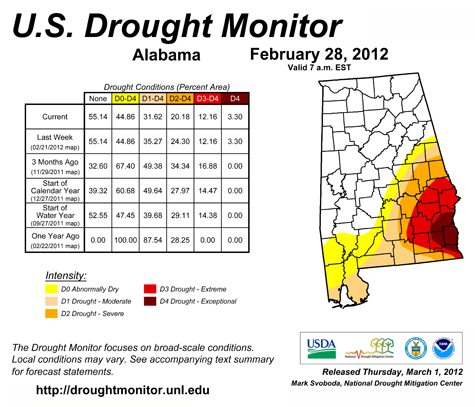 |
|||||||||||||||||||||||||||||||||||||||||||||||||||||||||||||||||||||||||||||||||||
| Copyright (c) 2010-2011 Alabama Office of the State Climatologist. All rights reserved. questions about this web page? Contact webmaster. |
|||||||||||||||||||||||||||||||||||||||||||||||||||||||||||||||||||||||||||||||||||
